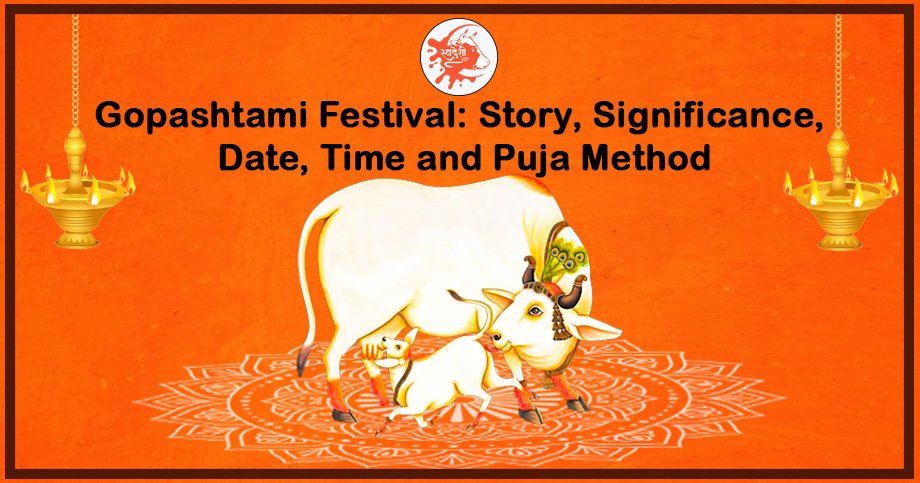
During the Shukla Paksha[1], on the 8th day of the Hindu month of Kartik, the Gopashtami festival is celebrated. The celebration honours both Lord Krishna and the cows. In the cities of Vrindavan, Mathura, and other Braj districts, the festival is celebrated with love and devotion. On this day, it is customary to worship and dress cows and their calves. On this particular day, Nanda Maharaja father of Lord Krishna entrusted to him the care of their cows. While visiting Vrindavan for the first time to graze the cattle, Nanda Maharaja decided to plan a feast for both Lord Krishna and Balaram. Now, this day is celebrated by us as the Gopashtami festival.
There are numerous stories connected to the Gopashtami festival. In most of the stories, Lord Krishna has been the subject of a most popular and common one. A story states that Nanda Maharaja assigned his children, both Lord Krishna and Lord Balarama, to graze their cows for the very first time on the particular day of the Gopashtami festival since they reached the Pauganda age, which is the age between 6 and 10 years. And hence, both would be full responsibility for herding the cattle going forward. Lord Krishna teaches us to worship and protect cows because he worshipped and we should celebrate them on occasions like Govardhan Puja or Gopashtami festival.
Another popular story claims that Lord Krishna advised the people of Braj to stop making any yearly offerings to Lord Indra. Due to his ego and his ensuing rage, Lord Indra wanted to demonstrate his dominance and power to the villagers. He decided to flood the entire region to force the people of Brij to bow down to him. The villagers saw continuous torrential rain for two whole weeks. To protect and shelter all living beings from Lord Indra’s fury, Lord Krishna lifted the Govardhan Parvat with his little finger. When Lord Indra understood his mistakes and admitted his defeat on the eighth day, he stopped the rain and begged Lord Krishna for forgiveness. Surbhi, the cow, then bathed both Lord Krishna and Lord Indra with her milk. Following that, she also declared Lord Krishna as Lord of Cows or Govinda. It is how the eight-day, popularly known as Asthami, became to be known as Gopashtami.
Cows in the Hindu culture are referred to as GauMata and are worshipped as goddesses. Cows are treasured by Hindus as the embodiment of their faith. We believe cows to be pure and holy creatures that should be worshipped on par with deities. Cows hold such a special place in Hindu hearts because, in every Hindu Mythology, it is mentioned that numerous celestial beings reside within them. Lord Krishna teaches us that cows should be protected and worshipped in many mythology stories. Those who embrace Krishna’s teaching should start worshipping and promoting cow welfare.
These holy animals are known to be the keeper of divine and spiritual qualities, and some even believe them to be a manifestation of Dharti Mata (Earth Goddess). Therefore, it is highly believed that individuals who worship cows (GauMata) on the eve of the Gopashtami festival would be granted a fortunate, prosperous, peaceful, and joyful life. On the holy day of Gopashtami festivals, people usually visit herders or the castle farms and worship cows with flowers, diyas, jaggery, gangajal, fruits, etc. Before offering prayers to cows, Hindus usually worship Lord Krishna by laying tilak on his forehead. The devotees then feed the cows jaggery, fruits, green peas, etc. Many devotees also donate money, food, and other items to the cow farm on the day of the Gopashtami festival.
Listed below are a few celebrations and rituals that are followed during the Gopashtami festival:

The Gopashtami Festival will take place on a set date. The Gopashtami festival is set to occur on November 1st, 2022.
Conclusion
They should be prayed to by applying tilak made out of sandalwood and roli. You must offer them incense sticks, fruits, flowers, and other items as well. Make sure you present Dakshina to cowherds after you have honoured and worshipped the cows. After performing these rites, perform parikrama (which means to make clockwise circumambulation of a holy being) and later feed them prasad and fodder. It is believed that worshipping the cows and their calves in this manner will bring you prosperity, fortune, and good luck. Before this write-up, we have also covered a blog on the Gorehabba cow dung festival and a blog related to Diwali. Stay tuned to the SwadeshiVIP Blog segment for more interesting write-ups.
Read our Article: Gorehabba Cow Dung Festival: A Theme Based On Throwing Cow Dung
